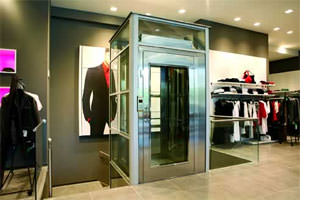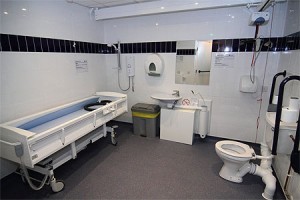PLEASE NOTE:
This blog post was released in 2012 and the NCC / BCA was amended in 2013 to remove the prescriptive requirements to use passenger lifts that comply with Australian Standards referenced within this web page. New passenger lifts must however continue to be provided the same level of accessible features. If in doubt, please contact this office.
 Prior to the introduction of the new access standards – Disability (Access to Premises – Buildings) Standards 2010 (Premises Standards) and the Building Code of Australia 2011 (BCA) in May 2011 – there were limited ‘deemed-to-satisfy’ lift options in the building regulations to cater for people with a disability associated with Class 2 to 9 buildings.
Prior to the introduction of the new access standards – Disability (Access to Premises – Buildings) Standards 2010 (Premises Standards) and the Building Code of Australia 2011 (BCA) in May 2011 – there were limited ‘deemed-to-satisfy’ lift options in the building regulations to cater for people with a disability associated with Class 2 to 9 buildings.
The introduction of the new access standards now allow for a number of lift options, but care is required to ensure that the correct type of lift is selected.
The problem that we have experienced is that some lift suppliers are promoting a number of lifts that are not appropriate to the proposed use of the building or fail to meet the requirements of the relevant Australian Standards and the new access standards.
Carpet Pile Heights – The Long and Short of it Carpet pile height is a particularly interesting area, and one that has been subject to a little confusion.
Carpet pile height is a particularly interesting area, and one that has been subject to a little confusion.
Australian Standard AS1428.1-2009 is referenced under both the Disability (Access to Premises – Buildings) Standards 2010 (Premises Standards) and the current Building Code of Australia (BCA). Carpet pile height is covered under Clause 7.4.1(a) of AS1428.1-2009, which requires carpet pile height or pile thickness not to exceed 6 mm and the carpet backing thickness not to exceed 4 mm. These dimensions are also reflected in Figure 8 of AS1428.1.
But, Clause D3.3(g) of the BCA states that Clause 7.4.1(a) of AS1428.1-2009 does not apply and states that ‘the pile height or pile thickness shall not exceed 11 mm and the carpet backing shall not exceed 4 mm’ . Also, Clause D3.3(h) of the BCA states that the carpet pile height or carpet pile thickness and the carpet backing thickness shown in Figure 8 of AS1428.1 are to be replaced with
11 mm and 4 mm respectively to be consistent with Clause D3.3(g).
The inconsistency between the Premises Standards and the BCA presents a dilemma for carpet selection – carpet with a 11 mm pile height or pile thickness will satisfy the BCA, but currently represents a non-compliance under the Premises Standards.
Accessible (Disabled) Car Parking RequirementsOn the 1 May 2011 the Commonwealth Disability (Access to Premises – Buildings) Standards 2010 (Premises Standards) was introduced resulting in dramatic changes to accessibility requirements in and around buildings.
The objectives of the Premises Standards are to ensure that ‘dignified, equitable, cost-effective and reasonably achievable access to buildings, and facilities and services within buildings, is provided for people with a disability’. It also aims to give certainty to building certifiers, building developers, building managers and other practitioners that compliance with the Access Code, forming Schedule 1 of the Premises Standards will achieve compliance with Section 23 of the Disability Discrimination Act 1993 (Access to Premises). The Premises Standards apply to new buildings and existing buildings undergoing building work.
The Access Code has been replicated within the Building Code of Australia, which now references three new Australian/New Zealand Standards that impact on car park designs:
Purchase 1300mm High Blue Flexible Disabled Carpark Bollards
1. ‘AS/NZS 2890.6-2009 Off-street parking for people with disabilities’;
2. ‘AS/NZS 1428.4:2009 Means to assist the orientation of people with vision impairment – Tactile ground surface indicators’ ; and
3. ‘AS1428.1-2009 General requirements for access – new building works’
AS/NZS 2890.6-2009 sets the minimum requirements for accessible car parking spaces in Australia and New Zealand and replaces the previous reference (Appendix C of AS2890-1-1993).
NOTE: I would normally not publish a private email but with this one from the AFL had to be an exception!
I have just received a very disappointing email from the AFL that relates to game accessibility for people with a disability as a response to a message I sent via their website.

There is another group of people that want to attend the football that simply cant! They are people with a disability that require parents/carers to change them due to incontinence. This is a bigger problem than most people are aware of.
This cannot be done away from home for adolescents through to adults within the community.
In the UK they have for a number of years been rolling out www.changing-places.org/to facilitate this for parents and carers. A similar programme is already being investigated within Australia. A changing place is a larger accessible toilet that includes an adult adjustable height change table and over head personal hoist.
Are you specifying or approving Tactile Ground Surface Indicators TGSIs?I thought I’d post this after having discussions with numerous people regarding equipment and equations. Most people are getting this wrong. Please note that the Standard defines two (2) ways to calculate luminance contrast (Building elements – TGSI’s use the same equation) – most people are just using the Bowman-Sapolinski equation for building elements other than TGSI’s. This equation is ONLY usable for luminous reflectance values and should not be used with luminance values. Luminance values need to use the equation in B5.3 (e) of 1428.1 – 2009. Note that if TGSI’s are being tested then the Bowman-Sapolinski equation is used – another interesting contradiction between these two standards.
And now a little about equipment – if you’re looking at buying some equipment to test contrasts – do yourself a favour and buy a Photometer. In most cases you will be testing in an on-site setting and this will be fine – note that if your testing TGSI’s then there is a set up that needs to be done. The biggest issue is the laboratory tests.
You cannot use the colorluminator, NCS or similar or any spectrophotometer. The reason for this is geometry.
Town Planning Car Parking Requirements Vs Disability (Access to Premises – Buildings) Standards 2010As of the 1 May 2011, the Commonwealth Disability (Access to Premises – Buildings) Standards 2010 (known as the Premises Standards) and the 2011 version of the Building Code of Australia (BCA) were enacted.
Both of these documents reference AS2890.6-2009 (rather than AS2890.1-1993) when designing accessible car parking spaces.
Unfortunately, planning schemes in Victoria still reference the old car parking code, AS2890.1-1993, which is now in conflict with the Premises Standards and the BCA.
Where there is a discrepancy between Commonwealth law (e.g. Premises Standards) and State law (e.g. Victorian planning schemes), Commonwealth law takes precedence over State law. However, it is possible that a planning authority (under its own heads of consideration) could accept such a reduced length, but it will now inadvertently be breaching the Premises Standards (Commonwealth law). On this basis, I suspect that VCAT (Victorian Civil and Administrative Tribunal), Councils or any other planning authority will no longer accept 4.9m long accessible car parking bays. Also, as the new accessible car parking requirements form part of the BCA, this conflict will cause difficulties for the building surveyor to approve an accessible car parking space that is 4.9m long as part of any future building permit process.
Webcast: Premises Standards awareness seminar 2010I would like to draw your attention to the the access to premises standards which will be included within the BCA commencing 1st May 2011.
It has allot of ramifications for all forms of developments including commercial, retail and for the first time residential needs have accessible features included.
I would suggest all developers & consultants work their way through the following webcast and get educated on the new requirements.
http://www.hreoc.gov.au/
If your have any queries tell them they can contact us without any obligation.
Retail Access can be simplifiedJust because structural changes are cost prohibitive this is an alternative solution we have recommended for a number of properties.
This is a great video explaining how it benefits not only the person in a wheelchair but the financial benefit to the retailer.
McCallum urges tolerance, acceptanceA blind lawyer and academic who continues to break stereotypes, Professor Ron McCallum has never let disability hinder his achievements.
He hopes being named Senior Australian of the Year for 2011 will help him achieve his ultimate aim: to ensure all people with a disability are treated equally.
“I feel greatly honored … greatly humbled, (although) I feel a very young senior,” the 62-year-old told reporters after the announcement of his latest achievement at Canberra’s Parliament House.
Advertisement: Story continues below Businessman and philanthropist Simon McKeon took out the Australian of the Year honours, while teenage sailor Jessica Watson and anti-suicide campaigner Donald Ritchie also received accolades.
Asked how he planned to spend 2011, Prof McCallum said he wanted to change the attitudes of everyday Australians to be more thoughtful about and accepting of the disabled.
They deserved to be treated equally, he said.
“We have inequality in our laws of access, difficulties in access in transport and information.
“We’re working hard on them, governments are working hard … (but) that’s where the inequality lies.
BP does not get disability!I was completely staggered when I saw the following Pumps.
Why would you design the pump handles to be so high, how on earth are people in wheelchairs supposed to use them?
I think BP need to go back to the drawing with the design of these pumps as they are totally unacceptable.